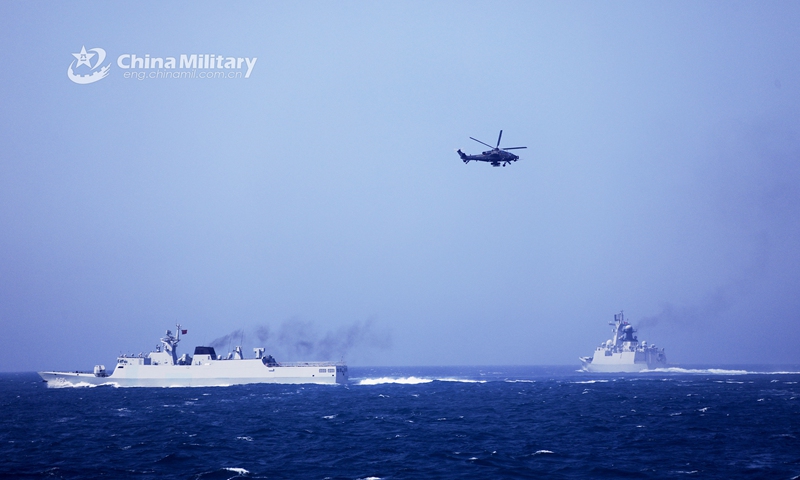Inforgraphic: GT
By Liu Xuanzun
China set its 2020 defense budget growth target at 6.6 percent, resulting in a draft budget of 1.268 trillion yuan ($178.2 billion), lower than the 7.5 percent growth in 2019.
The figure was made public on Friday in a draft budget report to be submitted to the annual session of the National People’s Congress (NPC).
This also marks the lowest defense budget growth rate in recent years.
This means China can provide sufficient funding for military development despite the economic impact brought by the COVID-19 outbreak, and while the growth has slowed down, it matches China’s current economic situation in the wake of COVID-19, analysts said on Friday.
China’s defense budget for 2019 was 1.19 trillion yuan, up 7.5 percent from 2018. China has maintained single-digit growth in its annual defense budget since 2016.
Song Zhongping, a Chinese military expert and TV commentator, told the Global Times on Friday that it is very normal that compared to last year’s 7.5 percent growth rate, this year’s 6.6 percent is not a significant slowdown considering the effect brought by the pandemic.
China is facing national security threats, including those taking place very nearby to China and in non-traditional security fields. Compared to these threats, China’s military expenditure was far from enough, Song said.
China is in need of moderate military budget growths to support its national defense, without which China’s economic achievements could be lost, Song said.
Wei Dongxu, a Beijing-based military analyst, told the Global Times on Friday that the increased defense budget can ensure the Chinese military’s major programs and key spending fields are not affected by the pandemic and will remain on schedule.
While the growth rate declined, which may prompt the Chinese military to make some choices in allocating expenditure, China’s overall national defense construction and the development of the military will not see a major impact, as enough funding is still available to key areas such as the development of new weapons and equipment, troops’ salaries and benefits and training expenses, Wei said.
The decreased growth rate is partially decided by China’s actual situation, and the pandemic has had an impact on economic growth in all countries, Wei noted.
Reasonable growth
China has scrapped a numerical economic growth target this year for the first time in decades.
China has kept its military expenditure/GDP ratio to under 2 percent in the past three decades, while other major countries like the US have been keeping this ratio to 3 to 4 percent in recent years.
With China’s economic volume growing, corresponding military strength is needed to protect it. Back when China’s economy skyrocketed at the beginning of reform and opening-up, military expenditure growth remained slow. Increasing the defense budget is only making up for what was lost back then, analysts pointed out.
Song said the defense budget growth rate of 6.6 percent for 2020 is not a high figure at all even under the COVID-19 pandemic.
China’s defense expenditure is categorized by application, namely personnel expenses, training maintenance fees and equipment spending, according to China’s Ministry of National Defense.
The Chinese military needs to procure a huge amount of expensive, advanced weapons and equipment to replace its vast arsenal of outdated ones; it is also boosting the intensity and extent of training; as the CPI increases, benefits of soldiers and officers also need to improve, Song pointed out.
The 6.6 percent growth rate of this year alone cannot solve China’s problem of the lack of military funding, but it is a process of gradual improvement, Song said, noting that if next year’s economic situation can be better, the military budget growth rate for next year should be higher.
The continued growth in the Chinese military budget comes at a time when the US is becoming increasingly aggressive and has conducted repeated military provocations against China in regions like the South China Sea and the Taiwan Straits.
Both regions have become flashpoints, which military observers say face the risk of escalating into actual military conflicts. The US has been sending warships and warplanes to waters and airspace near China more frequently, with some trespassing into Chinese territories. China has also been conducting patrols and exercises to safeguard its national sovereignty and territorial integrity.
China has huge national defense demands, which is a crucial factor in the military budget, a Chinese military expert who asked not to be named told the Global Times on Friday.
In the post-pandemic period, China faces more military threats from other countries, mainly the US. With Taiwan secessionists becoming more and more rampant, reunification by force with the island of Taiwan is always on the table, the expert said, noting that in this situation, increasing the defense budget must not stop.
China takes the development of the economy and the demands of national defense into consideration when deciding on the appropriate scale and composition of defense expenditure, according to the national defense white paper issued by the State Council Information Office in July 2019.
The 2020 defense budget should be seen as reasonable and appropriate, analysts said.

An attack helicopter hovers over the sea as the guided-missile frigate Chaozhou (Hull 595) navigates in formation with another vessel during a coordinated operation of a maritime realistic training exercise conducted by a frigate flotilla with the navy under the PLA Eastern Theater Command from May 8 to 11, 2020. (eng.chinamil.com.cn/Photo by Zhou Daoxian)
Not a threat
China’s military budget increase has been a hot topic for some Western officials and media to hype the “China threat” theory. An increase this year against the background of the COVID-19 pandemic could raise this rhetoric again, observers said.
“People should ask first, which countries are threatening China’s national security in the first place? They should ask the US, they should ask India, and some other neighboring countries and regions,” Song said.
China has contained the COVID-19 epidemic well, and its military contributed a lot and has demonstrated its capabilities. More spending will be put to strengthen the Chinese military’s capability in epidemic control and prevention as well as disaster relief, Song noted.
Whether a country poses a military threat to others or not is decided by its diplomatic and national defense policies and not by how much it increases its defense budget, Chinese officials and military experts said in previous years.
China has only a limited defense budget, and it is used for safeguarding the country’s sovereignty, security, and territorial integrity. This will not pose a threat to other countries, they said.
According to a report released by the Stockholm International Peace Research Institute (SIPRI) in April, the US drives global military expenditure growth, spending a whopping $732 billion on the sector in 2019, about four times higher than China’s official figure.
In response to a question saying China’s military spending was not transparent, Zhang Yesui, spokesperson for the third session of the 13th National People’s Congress, said at a press conference on Thursday that China has been submitting reports on its military expenditures to the United Nations every year since 2007.
“From where the money comes from to how the money is used, everything is accounted for,” Zhang said, noting there is no such thing as “hidden military spending.”


